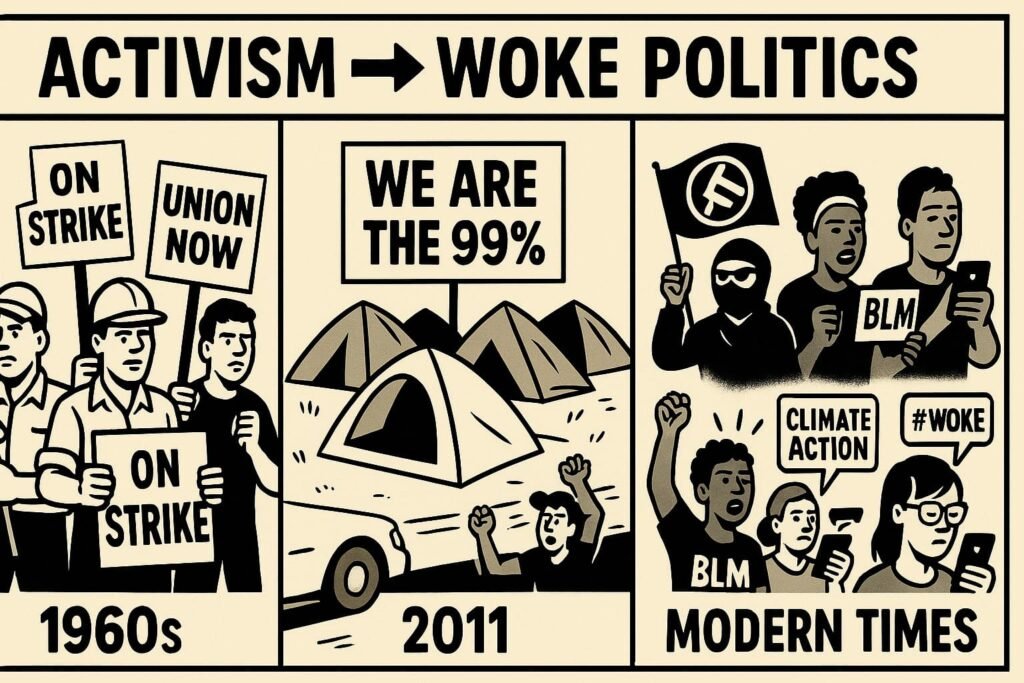Activism Explainer Hub
How protest became the fuel of woke politics
Activism used to mean marches, unions, and hard fights over wages and laws. Today it also means hashtags, NGOs, climate blockades, and endless culture wars. Some movements start noble and end in chaos. Others begin with chaos and call it noble.
The Activism Explainer Hub shows how different movements — from Antifa to BLM, from #MeToo to Extinction Rebellion — shaped today’s political landscape. You’ll see how outrage gets organised, monetised, and weaponised.
👉 Explore the 11 key explainers below:
🟥 Street Activism – From Masks to Movements
Street activism shows how protests turned into permanent street theatre. From Antifa’s black-bloc tactics to BLM’s radical alliances, these movements brought confrontation into the mainstream.
- Antifa Explained – From Anti-Fascism to Anarchist Chaos
- BLM Explained – From Justice to Radical Alliances
🟪 Cultural Uprisings – Identity & Reckonings
Cultural activism shifted the battleground from the streets to everyday life. #MeToo and digital hashtags rewired politics around personal identity, outrage, and viral campaigns.
- #MeToo Explained – From Reckoning to Backlash
- Digital Activism Explained – Hashtags and Online Uprisings
🟩 Climate Activism – Rage at the End of the World
Climate protests fused environmental fears with radical politics. From Extinction Rebellion’s anarchist stunts to the Sunrise Movement’s youth campaigns, climate activism became a global brand of disruption.
- Extinction Rebellion Explained – Radical Climate Politics
- Sunrise Movement Explained – Climate Youth Activism
🟦 Turning Points – When Protest Collapsed into Chaos
Some uprisings became turning points in modern politics. Occupy Wall Street shifted the fight from class to woke identity, while Portland 2020 and Seattle’s CHAZ showed how justice movements could spiral into anarchist “autonomous zones.”
- Occupy Wall Street Explained – From Class to Woke Politics
- Portland 2020 Explained – Utopia Meets Anarchy
- Capitol Hill Occupied Protest Explained – CHAZ’s Utopian Failure
🟨 Boundaries of Activism – Class & Chaos
Not all activism is identity politics. Labour strikes remind us of material struggle, while terrorism exposes the dangerous line where protest turns into violence.
- Labour Strikes Explained – Activism Beyond Identity Politics
- Terror vs Activism Explained – Where Violence Gets Justified
Why it matters:
Each of these movements tells us something bigger: how society went from fighting over class and wages to fighting over identity and language. From street barricades to corporate boardrooms, activism became the raw material of woke politics.
❓ FAQ
What is activism in plain English?
Activism means organised action to demand change — from strikes and marches to hashtags and online campaigns.
How has activism changed in recent years?
It shifted from class-based struggles to identity politics, digital hashtags, and NGO-driven movements that often fuel culture wars.
Why is activism linked to woke politics?
Because modern activism uses identity, language, and outrage in ways that corporations and institutions adopted to gain power and legitimacy.
What are examples of modern activism?
Antifa, Black Lives Matter, #MeToo, Extinction Rebellion, Sunrise Movement, Occupy Wall Street, CHAZ, Portland 2020, and labour strikes.
Why does activism matter today?
Because it doesn’t just change laws — it reshapes culture, business, and daily life, turning protest into a permanent feature of politics.



